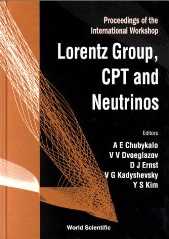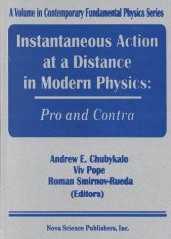Publisher: Rinton Press Inc.
Year: 2004
ISBN: 1589490363
ISBN: 978-1589490369
Kotelnikov suggested an electrodynamics which can describe also particles which are faster than light. This suggestion is in agreement with special relativity.
We know Hector Munera from his interpretation of the Michelson-Morley experiment which, according to Munera, did show an aether drift. In this book, he presented a new approach to the electromagnetic force.
Caroline Thompson presented, for the first time, her phi-wave aether model.
Most revolutionary and far-reaching is K?hne's quantum electromagnetodynamics. His theory is a generalization of quantum electrodynamics. It includes Dirac magnetic monopoles and two kinds of photon, the conventional one which he named "electric photon" and a new one which he named "magnetic photon". His theory is the only quantum field theory of the electromagnetic interaction which can explain the quantization of electric charge, which is local, which is manifestly Lorentz invariant, which describes electrism and magnetism symmetrically, which does not require the Dirac string, and which makes testable predictions.
K?hne's theory predicts that the magnetic photon couples with electric charges, where the coupling strength depends on the absolute motion of the electric charge. As a consequence, the creation, shielding and absorption of magnetic photons is suppressed by a factor of 700 000 with respect to electric photons of the same energy.
As K?hne pointed out, his theory violates the relativity principle.
But what is more: K?hne had presented his theory and suggested an experiment to test his theory already in 1997 (http://arxiv.org/abs/hep-ph/9708394). Now, in his contribution to this book he discussed three independent experiments which confirm his magnetic photon rays.
The far-reaching consequences of this probable discovery include:
- The discovery of a new elementary particle (magnetic photon)
- The discovery of a new radiation (magnetic photon rays)
- Possible applications in medicine (examinations via magnetic photon rays instead of X rays)
- The first proof for the violation of the relativity principle of special relativity
- Indirect evidence for magnetic monopoles
- Indirect evidence for an aether
Wow, could this mean a Nobel prize within the near future?
Anyway, this book is very good. I recommend this book to everyone who is interested in physics and/or the philosophy of science. - Peter M?ller, Amazon
Pages: 466
Publisher: World Scientific Publishing Company
Year: 2001
ISBN: 9810240627
ISBN: 978-9810240622
Pages: 475
Publisher: Nova Science Publishers
Year: 1999
ISBN: 1560726989
ISBN: 978-1560726982
Websites: www.poams.org www.vivpope.co.uk
The editorial approach is unusual in that in order to break the current conceptual deadlock and to encourage true innovation they have solicited inputs which are multidisciplinary. This open-ended venture is therefore perhaps more in line with what was once called Natural Philosophy than with what is currently known as 'Physics'. This is something of a departure for those who say that Physics no longer has anything to do with Philosophy. For there are physicists who believe that their predecessors have accomplished all the really important conceptual work on interpreting natural phenomena, so that there is no longer any call for radical revision in that direction. This leads to a constricted form of the discipline in which the purpose of all observation and experimentation is seen as simply to collect more and more information and fit it to conceptions which are traditionally 'cut and dried'.
The emphasis is thus on presenting informed and carefully considered descriptions of natural phenomena, economizing as far as possible on interpretations in terms of entities which turn out to be no more than speculative.




